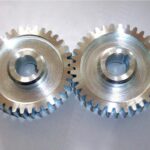To obtain the expected velocity ratio of two tooth profiles, the normal line of their profiles must pass through the corresponding pitch point, which is decided by the velocity ratio. The two profiles which satisfy this requirement are called conjugate profiles. Sometimes, we simply termed the tooth profiles which satisfy the fundamental law of gear-tooth action the conjugate profiles.
Although many tooth shapes are possible for which a mating tooth could be designed to satisfy the fundamental law, only two are in general use: the cycloidal and involute profiles. The involute has important advantages; it is easy to manufacture and the center distance between a pair of involute gears can be varied without changing the velocity ratio. Thus close tolerances between shaft locations are not required when using the involute profile. The most commonly used conjugate tooth curve is the involute curve.
conjugate action : It is essential for correctly meshing gears, the size of the teeth ( themodule ) must be the same for both the gears.
Another requirement – the shape of teeth necessary for the speed ratio to remain constant during an increment of rotation; this behavior of the contacting surfaces (ie. the teeth flanks) is known as conjugate action.


